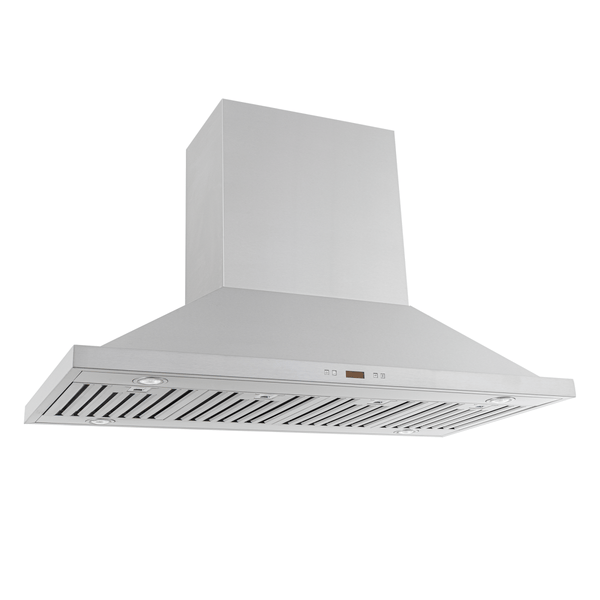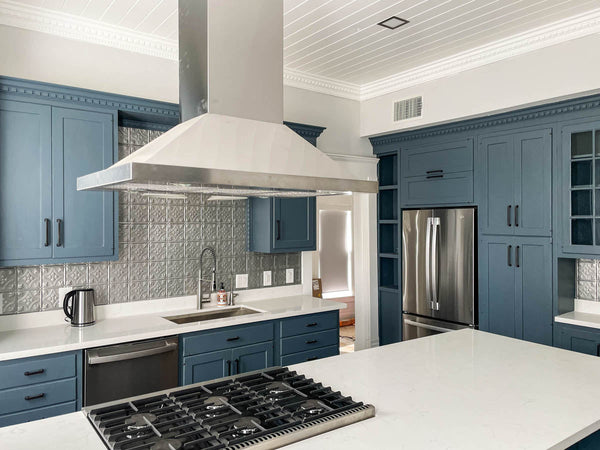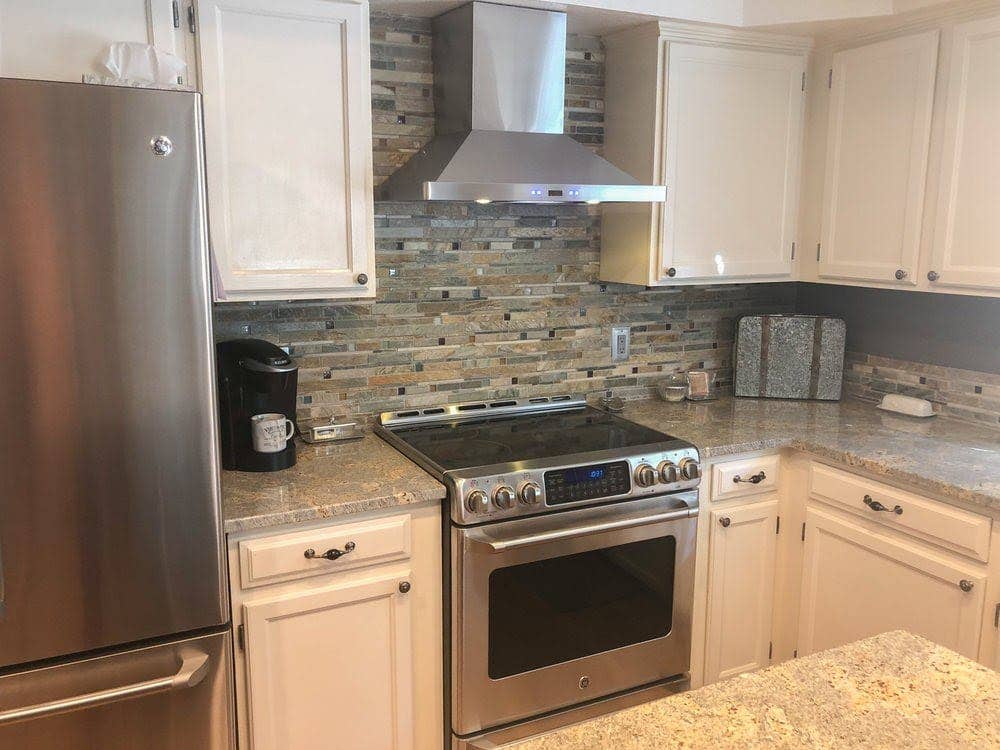As you use your range hood, you may encounter problems with the range hood lights or the fan. These are often electrical or related to malfunctioning range hood parts. Before replacing any parts, troubleshoot the electrical connections to your hood.
To troubleshoot electrical issues, try the following:
- Test the power to your standard outlet.
- Check your fuse box for a blown fuse.
- Make sure there are no loose wires inside the range hood (circuit board, lights, control panel).
Or to ensure that your range hood parts work efficiently, check out this list:
- Inspect the circuit board.
- Inspect all switches.
- Replace the control panel.
- Replace your driver.
- Replace burnt light bulbs.
- Replace the light socket.
- Tighten the blower.
- Inspect your fan blades.
Continue reading to learn more about how to troubleshoot your range hood fan and lights.
First, troubleshoot the electrical components of the hood before inspecting it. Here are a few things to try.
Test the power to your standard outlet.
Most range hoods are powered using a standard 110V outlet - the typical three pronged outlet in American homes. Sometimes, this outlet can short circuit or become overloaded.
Your outlet could be overloaded.
Outlets often overload when there are many electrical devices or appliances hooked up to them. If that’s the case, unplug some of the electrical devices from the outlet before flipping your breaker. If not, it’s unlikely that this is the problem.
Keep reading to continue troubleshooting.
Plug in a different appliance to test the outlet. If it doesn’t work, check your circuit breaker.
To test the power to your outlet, turn off your vent hood, unplug it, and plug in another appliance around your home. Then, test that appliance. If you are able to turn it on, the outlet is working fine.
But, if your appliance doesn’t work when you plug it in, check your circuit breaker. As a result of the short circuit or electrical overload, the breaker may have flipped.
Be sure to unplug all electrical devices before flipping your breaker.
A fuse may have blown.
If your standard outlet does not have power, either your circuit breaker has flipped or you blew a fuse. On your circuit breaker box, look for melted metal or discolored glass to find the blown fuse.
To replace the fuse, consult an electrician or visit your local hardware store to find a fuse that has the appropriate amperage.
You can use a multimeter to test if the fuse has a continuous electrical current. If the multimeter beeps, that’s great. That means the current is continuous. If not, the fuse is blown.
Here’s exactly how to test continuity using a multimeter.
If you hardwired your range hood…
...double-check the wires. First, flip the breaker that powers your range hood for safety reasons. Working with electricity is dangerous. Make sure there are no loose connections.
Second, double-check that you’ve matched the wire colors. If your wires are mismatched, consult a professional electrician to troubleshoot your range hood. Or, call your range hood manufacturer.
Check other wire connections (circuit board, lights, control panel).
While your breaker is flipped off, remove your filters and inspect the wire connections to the circuit board, lights, and control panel. Make sure that these connections are nice and tight. You might need to add new electrical tape or tighten the wire nuts or caps.
Once you’ve tested all the electrical components, if you haven’t identified the problem with your hood, move on to troubleshooting the hood itself. Here are eight ways to troubleshoot your range hood fan and lights.
Troubleshooting Your Range Hood
Inspect the circuit board.
If your range hood fan is not working, the circuit board could be faulty. In most cases, if the touch panel is lighting up and functions through each speed without the blower working, check the circuit board.
Look for melted components, dark or burnt areas, or broken pieces to identify if the hood is working. If not, talk to your manufacturer to buy a replacement circuit board.
Inspect all switches.
The control panel connects to the fan and lights, so it’s important to ensure that electricity is running to the switches. Call your range hood manufacturer for a wiring diagram to find the wires connecting your switches. Then, use a multimeter to test the electrical current. If you don’t detect a current, ask for a replacement switch.
Replace the control panel or touch panel.
If you can’t replace individual switches, you might need to replace your control panel. Specifically, if it doesn't turn on or function at different speeds, replace the touch panel.
Also, the control panel is connected to the range hood lights, you might need to replace it to fix them. Before doing so, check the driver, light bulbs, and light socket as detailed below.
Replace your driver.
If your lights are not working, you might have a blown LED driver. Some range hoods need a driver to regulate the high-voltage electricity that comes from a standard home outlet.
Replace burnt light bulbs.
Your lightbulbs may be burnt out due to their age, a malfunction, or excessive heat. LED light bulbs, in particular, do not handle heat well – about 50º C+ of consistent heat is the upper threshold.
So if your light bulbs are mounted close to a hot range or stainless steel grill, the intense heat will wear them down over time.
You might also end up installing a range hood with faulty lights, which happens occasionally.
Finally, after many years of use, your LED bulbs will eventually burn out.
Call your range hood manufacturer to troubleshoot your lights and order a replacement.
Replace the light socket.
If the bulbs themselves are working fine, you may need to replace your light socket. Like most range hood parts, you can test the bulbs with a multimeter. If your light socket does not have power running through it, it needs to be replaced.
It also may be working, but your LED bulbs won’t turn on. As long as your bulbs are not burnt out, this means the light socket needs to be replaced. Your range hood manufacturer should be able to help you troubleshoot the light socket.
Tighten the range hood fan.
To keep everything securely in place, tighten the screws on your fan motor. Also, check to see that the fan blade is secured in place so that it can spin properly.
To inspect the fan blade or blades, unscrew the plastic housing of the blower using a screwdriver.
Inspect your fan blades.
Make sure that your fan blades spin smoothly. If anything is impeding the blades, your blower may become damaged over time.
The touch sensor on my range hood is not working for my lights only. What should I do?
If it’s only your lights that aren’t working, the issue is probably with the lights themselves – not your touch sensor. First, check to make sure that your range hood bulbs are not burnt out. If they are burnt out, replace them. If new bulbs don’t work, you might have a bad LED driver; you can ask the manufacturer for a replacement. If you’ve tried all this, call your manufacturer and ask for a touch panel replacement.
My kitchen hood is emitting a strong chemical with a burning odor coming from the motor. What should I do?
First, turn off and unplug the range hood. If it’s emitting a strong chemical from the motor, you don’t want to put it under more strain. Call your manufacturer to ask for a replacement motor immediately.
That concludes our article on troubleshooting the fan and lights on your range hood. If you’re still having an issue with your fan, call your manufacturer for more information.
If you own a Proline hood, you can call us at (877) 901 - 5530. At Proline, if simple fixes don’t work, we send out parts one at a time to see if replacing individual parts will fix an issue.
Sometimes, what we think will fix the issue doesn't fix it. In that case, we send the rest of the electrical internal components to you to get the issue resolved.
Thanks for reading. For more helpful information on range hoods, check out the articles below.
Related Articles
Can I use an LED bulb in my range hood?











